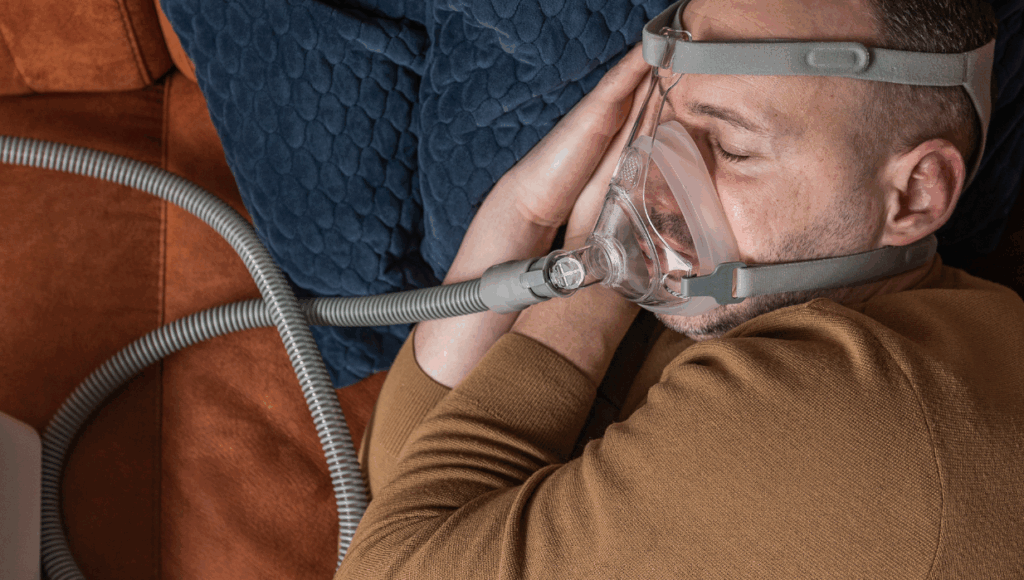The use of telemedicine in home mechanical ventilation
Understanding the professional guideline
Content Table
This guideline includes information from the European Respiratory Society about the use of telemedicine in people using home mechanical ventilation. It is based on a longer version, produced by a group of experts on the topic, which included healthcare professionals and people with personal experience of lung disease.
Introduction
Who is this document for and what is it about?
This document explains the recommendations in the European Respiratory Society (ERS) clinical guidelines for the use of telemedicine in home mechanical ventilation in people with chronic respiratory failure. It is for people using or considering using home mechanical ventilation, their family or carers.
What are clinical guidelines?
Clinical guidelines are produced after a scientific process used to gather the latest evidence on a condition or symptom. Guidelines also take into account the opinions of experts and the priorities of patients and carers who have experience of a condition. Clinical guidelines are written for healthcare professionals. They use them as a best practice document on how to diagnose, manage and treat a condition.
What does this document include?
This document summarises the key points from the clinical guidelines on the use of digital platforms, known as telemedicine, to monitor people receiving ventilation to help them breathe at home. The guideline specifically looks at people who have an ongoing serious condition which impacts breathing, known as respiratory failure
This page explains these guidelines in a way that is easier to understand for people who do not work in a medical field. It describes the recommendations for the use of telemedicine for people using home mechanical ventilation and includes information on the standards to aim for to ensure that care works well.
The recommendations from this guideline are classed as “conditional” because there is a lack of evidence on the topic. This means that healthcare professionals may suggest different treatment options in discussion with individuals.
![]() Strong recommendations, where there is good evidence and/or general agreement from the authors of the guideline.
Strong recommendations, where there is good evidence and/or general agreement from the authors of the guideline.
![]() Conditional recommendations from the full guideline are shown in this document with this icon.
Conditional recommendations from the full guideline are shown in this document with this icon.
![]() The authors of the guideline were unable to make a recommendation.
The authors of the guideline were unable to make a recommendation.
![]() Recommendation against, where there is good evidence and/or agreement against a particular treatment or approach.
Recommendation against, where there is good evidence and/or agreement against a particular treatment or approach.
By providing this information in an accessible way, this document aims to help people with long-term respiratory failure understand more about the care they should receive. This can help them to feel informed when making decisions about their treatment options.
What is chronic respiratory failure?
The clinical guideline refers to “chronic respiratory failure”. This happens when breathing fails in the long-term, leading to lower levels of oxygen and higher levels of carbon dioxide in the blood. This can be caused by:
- conditions affecting the nerves and muscles that control breathing, such as muscular dystrophy, stroke, amyotrophic lateral sclerosis (a type of motor neuron disease) or conditions that cause paralysis of the diaphragm
- lung conditions such as chronic obstructive pulmonary disease (COPD) or cystic fibrosis
- conditions where the chest is not in its natural shape, such as kyphoscoliosis
Symptoms of long-term respiratory failure include:
- breathlessness
- drowsiness
- confusion
- breathlessness when lying down (orthopnoea)
- morning headache
- fatigue or lack of energy
- fluid retention
What is home mechanical ventilation and how is it used?
Home mechanical ventilation refers to ways of supporting an individual’s breathing at home, away from the hospital. It is used to ease symptoms and improve the quality of life of people with long-term breathing problems. A machine is used to supply air through a mask worn over the nose or mouth, or through a tube in the neck. This helps the lungs to transfer oxygen into the blood, and to remove the carbon dioxide gas produced by the body.
The use of home mechanical ventilation is increasing. In Europe, its use has more than doubled since the year 2000. At first, it was used in people with neuromuscular diseases and restrictive thoracic diseases, but in recent years there has been a rise in the number of people using it for obesity hypoventilation syndrome and chronic obstructive pulmonary disease (COPD).
What is telemedicine and how is it used?
“Telemedicine” describes ways of providing healthcare remotely, using telephone, video consultations, or online platforms. It can be used to diagnose or monitor a condition. Information about breathing can be collected from ventilator machines and this can be reviewed by the home mechanical ventilation team who can adjust the prescription for the ventilator. This can mean fewer hospital visits, and more personalised care.
As technology improves, information gathered from ventilators can be monitored continuously. New software and apps are becoming available that can collect data from different places, improving coordination between different aspects of healthcare.
Recommendations
Using telemedicine when starting long-term home mechanical ventilation
Traditionally, home mechanical ventilation has been started in hospital. Starting at home can reduce the impact of hospital stays for individuals. It is important that people using home mechanical ventilation receive support and training from the home mechanical ventilation team, and this can be done remotely, using telemedicine.
![]() Telemedicine should be used at the start of home mechanical ventilation in people with neuromuscular diseases, restrictive thoracic diseases or chronic obstructive pulmonary disease.
Telemedicine should be used at the start of home mechanical ventilation in people with neuromuscular diseases, restrictive thoracic diseases or chronic obstructive pulmonary disease.
Researchers compared the start of home mechanical ventilation with standard care starting in hospital. They monitored:
- carbon dioxide levels, which show how well you are breathing;
- the number of hours per day that people were using the ventilator.
They found these measurements were similar in both people starting mechanical ventilation at home using telemedicine, and those starting it in the hospital. Although some technical problems were reported in the telemedicine group, starting mechanical ventilation at home with telemedicine was preferred by patients and found to be as safe as hospital care.
![]() No recommendation is made for or against the use of telemedicine when starting home mechanical ventilation in people with obesity hypoventilation syndrome.
No recommendation is made for or against the use of telemedicine when starting home mechanical ventilation in people with obesity hypoventilation syndrome.
There was not enough evidence to make a recommendation for the way mechanical ventilation was started in obesity hypoventilation syndrome, because of a lack of studies in people with this condition.
Using telemedicine to follow-up individuals on home mechanical ventilation
It is important that people using home mechanical ventilation receive support to use the technology, and that the effects of the treatment on their health are monitored over time. Telemedicine can be used to give ongoing information about a person’s health, and to support them and their caregivers to manage their condition.
![]() In people using long-term home mechanical ventilation, follow-up may be carried out either with or without telemedicine.
In people using long-term home mechanical ventilation, follow-up may be carried out either with or without telemedicine.
Researchers measured how well a person continued using their treatment, hospital visits, quality of life, how well the lungs were working and the need for visits to the doctor’s clinic or emergency department. They found these measurements were similar in both people who received follow-up using telemedicine and those using traditional visits to a hospital.
To what extent should wider remote monitoring be used in follow-up of home mechanical ventilation?
Information collected remotely could be used to monitor many aspects of health and improve care. In people using home mechanical ventilation, data from the ventilator could be combined with information from wider remote monitoring about symptoms, sleep quality, gas exchange and ventilator synchrony. This could predict exacerbations, reduce hospital visits and improve survival. However, increasing home-based monitoring may increase the burden on individuals and their caregivers.
![]() No recommendation is made on the use of extensive remote monitoring compared to limited remote monitoring (only using ventilator data) in people on long-term home mechanical ventilation, due to a lack of studies.
No recommendation is made on the use of extensive remote monitoring compared to limited remote monitoring (only using ventilator data) in people on long-term home mechanical ventilation, due to a lack of studies.
Views and experiences of people using telemedicine with home mechanical ventilation and their caregivers
Overall, people using home mechanical ventilation and their caregivers were satisfied with telemedicine. They reported improved health, wellbeing and confidence. Key experiences included:
- Patients and caregivers reported positive experiences with telemedicine, for example having to visit hospital less often, and having better communication with the home mechanical ventilation team. It was felt that telemedicine presented an opportunity to get the necessary care quickly and to reduce unnecessary medical treatments. Telemedicine reduced the burden for people with complex health needs. No major worries or harms were reported.
- Using telemedicine reduced travel to clinics or appointments, saving time and money. It reduced exposure to transport issues and limited the risk of infection. Reducing the need to travel to appointments reduced caregiver workload, leading to less stress and easing the mental burden of organising travel.
- Caregivers reported improved wellbeing as a result of the extra support and information. However, there was also an increased sense of responsibility for ensuring that the devices function smoothly.
- The remote monitoring was considered reassuring for people using ventilators who lived alone; there was a sense of constant supervision without needing to have a caregiver at the same location. However, some people felt that the treatment felt impersonal. Education and support should be available to people starting home mechanical ventilation with telemedicine, and their caregivers. It was reported that reducing contact time with nurse/clinician specialists may lead to individuals and their caregivers feeling less confident, and so requiring more reassurance, education and troubleshooting.
- Patients and caregivers found some challenges, for example, making adjustments to the ventilator settings and making physical adjustments to masks. The cost was also raised as a challenge for some.
- Overall, patients and carers were very positive and greatly believed in the future applications of AI and self-management using telemedicine for home mechanical ventilation.
Telemedicine may not be suitable for everyone, for example people whose illness is severe. It is important that individuals who are not able to access telemedicine (for example because of poor WiFi connection, people who are less able to use digital technologies or who are not willing to adopt new technologies) are able to receive in-person support from the healthcare team.
What factors affect the use of telemedicine in home mechanical ventilation?
The ability to provide telemedicine services varies in different areas. It can be affected by technology, regulations, the healthcare institutions providing the care, and patient-based factors.
Barriers to the use of telemedicine:
- Technology: communication issues (video/audio “lag”), speed of data transmission, incompatibility of different operating systems, and issues with collecting data from a ventilator.
- Patient factors: lack of access to the internet, increased electricity costs, low digital literacy
- Healthcare institutions: high costs, lack of openness in how the data are used, limited evidence of how cost-effective it is
- Regulatory: poor legal frameworks and lack of reimbursement schemes
Factors supporting the use of telemedicine:
- Technology: increased access opportunities for rural areas, devices are becoming more user-friendly, there is increased compatibility between telemonitoring platforms
- Patient factors: enhanced self-awareness and confidence, improved how much a person continued with their ventilation, reduced travel distance and costs, decreased hospital visits, cost savings
- Healthcare institutions: able to provide care quickly, cost savings, effective education and communication with patients, evidence-based protocols and guidelines
- Regulatory: collaboration with regulatory agencies, simplification of privacy/security issues, adequate reimbursement, clear regulatory frameworks
There are some risks of providing care through telemedicine instead of in-person care. For example, equipment or software may fail, electronic data can be manipulated, and data sent over the network may not be well protected.
What research needs to be done in the future?
Further research is needed to give stronger evidence about the use of telemedicine in home mechanical ventilation.
- More information is needed about which patients would benefit most from starting mechanical ventilation at home using telemedicine.
- Research should consider what kind of information a patient or caregiver needs to start home mechanical ventilation at home, such as online videos or other documents.
- Hospitals and ventilator manufacturers should work together on how much information is gathered and to combine telemonitored ventilator data with outcomes such as exacerbations, hospitalisations and survival.
- Studies are needed to find out how using telemedicine to start home mechanical ventilation affects healthcare costs in different healthcare systems.
- Comparing care using telemedicine to other types of care given outside the hospital.
- Investigation of different ways to monitor people using home mechanical ventilation.
- What is the role of automatic modes of titration (adjusting the amount of ventilation until it is most effective) and monitoring?
- Strategies should be developed to make sure everyone has equal access to starting and continuing home mechanical ventilation using telemedicine.
Further reading
This guideline was produced by the European Respiratory Society and the European Lung Foundation. You can find out more about these organisations and access the full professional guideline using the links below:
Full clinical guideline – published in the European Respiratory Journal in 2025.
About ERS
The European Respiratory Society (ERS) is an international organisation that brings together physicians, healthcare professionals, scientists and other experts working in respiratory medicine. It is one of the leading medical organisations in the respiratory field, with a growing membership representing over 140 countries. The ERS mission is to promote lung health in order to alleviate suffering from disease and drive standards for respiratory medicine globally. Science, education and advocacy are at the core of everything it does. ERS is involved in promoting scientific research and providing access to high-quality educational resources. It also plays a key role in advocacy – raising awareness of lung disease amongst the public and politicians. www.ersnet.org
About ELF
The European Lung Foundation (ELF) was founded by ERS to bring together patients and the public with professionals. ELF produces public versions of ERS guidelines to summarise the recommendations made to healthcare professionals in Europe, in a simple format for all to understand. These documents do not contain detailed information on each condition and should be used in conjunction with other patient information and discussions with your doctor. More information on lung conditions can be found on the ELF website: www.europeanlung.org
Patients’ perspective
Stien van Meerloo Meintema and Hans van Meerloo talk about their experience of home mechanical ventilation as a patient and carer. They share what they feel are the benefits of starting this kind of treatment at home. They shared this with professionals during a session discussing new guidelines on home mechanical ventilation at the European Respiratory Society’s annual Congress in 2025.
Glossary
Adherence: the extent to which someone follows the health advice or treatment plan agreed with healthcare professionals.
Chronic obstructive pulmonary disease (COPD): a long-term condition that causes inflammation in the lungs, damaged lung tissue and a narrowing of the airways, making breathing difficult.
Digital twin: a digital replica of a person, system, object or process. The model can collect patient data digitally in real time, and provides insights using advanced simulation techniques. The data can be used to benchmark, validate and improve the model. Digital twin data can provide additional insights into people’s lifestyles, environment and state of mind, which can affect the personalised implementation, titration and success of treatment.
Exacerbation: a noticeable worsening of a condition.
Follow-up: observation over a period of time of a person, group or defined population to observe changes in health status, or health- and social care-related variables.
Health-related quality of life: a combination of a person’s physical, mental and social wellbeing; not just the absence of disease. This can include emotions, sleep, social life, how energetic a person feels, and general life satisfaction. In respiratory illness, health-related quality of life is measured using questionnaires such as the St George’s Respiratory Questionnaire and the Chronic Respiratory Questionnaire.
Obesity hypoventilation syndrome (OHS): a combination of obesity, daytime high levels of carbon dioxide and abnormal breathing during sleep.
Obstructive sleep apnoea (OSA): a condition in which the individual is briefly unable to breathe when asleep, due to temporary obstruction of the windpipe. This affects the quality of sleep, leading to daytime sleepiness and effects on the heart and blood pressure.
Ventilator–patient synchrony: how well the support from the ventilator matches the timing and effort of a patient’s breaths.
Virtual reality: a simulated three-dimensional environment that allows learners to interact with virtual objects and observe their effects in real time. It can be used for support and basic troubleshooting, increasing confidence in their ability to perform a task and providing opportunities to refresh knowledge and skills.
Wearable technology: electronic devices that are used to collect and communicate information about the body. Examples include smartwatches, implants, patches, rings and smart tattoos.





